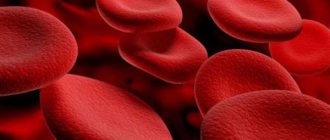Pregnant women should undergo regular examinations and have their blood tested, because based on the state of the blood serum, medical specialists determine the condition of the fetus and the expectant mother. So, if the hematocrit is low during pregnancy, the expectant mother should consult a gynecologist as soon as possible.
General definition
Hematocrit is the ratio of plasma volume to blood cells (red blood cells). It is measured as a percentage and determined in a clinical blood test. It is designated by Latin characters – Ht.
Hematocrit is reduced during pregnancy (the 1st, 2nd, and 3rd trimesters can occur with the development of pathological conditions in the body) for several reasons. Its assessment is one of the main diagnostic criteria. It is determined to screen the general condition of the body.
Indications for examination may include the development of various disturbing symptoms that indicate the development of pathology. Blood tests are also carried out routinely to assess the general condition of the body.
Myelocytes in a clinical blood test during pregnancy and the norm
Myelocytes (Mie) and metamyelocytes. The transcript of a clinical blood test during pregnancy may indicate a parameter such as myelocytes. Normally, myelocytes and metamyelocytes are not a good sign; they should not be in the blood of a healthy person, be it an adult or a child. These cells are an immature form of granulocytes (a type of white blood cell), and their presence in the analysis results is a sign of pathological processes in the body. If the body has released immature granulocytes (myelocytes) into the blood, this indicates that the body's protective resources are almost exhausted.
Indications for examination
Main indications for performing a clinical blood test:
- Pregnancy. During pregnancy, blood testing is the main diagnostic method. For each trimester there is a specific order. In the 1st trimester, blood tests are performed 2 times a month. In the 2nd and 3rd trimester 1 time, every 2 weeks. According to indications, more frequent blood sampling for analysis is possible.
- Diagnosis of anemia. Allows you to identify the development of pathology, and a blood test is performed to monitor the patient’s condition and the effectiveness of the treatment.
- Diagnosis of polycythemia (a pathological condition in which the number of red blood cells in the blood increases).
- Infectious diseases. During infectious diseases, hematocrit testing is important. It helps prevent the development of dehydration. Hematocrit also has a special diagnostic value for malaria. Its reduced value is the main sign of the development of this infection.
- Symptoms. If you experience headache, fatigue, weakness, pale skin, changes in appetite, increased body temperature - all of these are indications for a clinical blood test.
- Assessment of body dehydration. Allows you to assess how severe dehydration is in a person and whether this condition requires the introduction of additional fluid into the body. In addition, systematic monitoring of the patient’s condition after prolonged fluid loss is carried out.
- Assessment of the need for blood transfusion and its components (blood transfusion).
- Monitoring the patient's condition during blood transfusion and assessing the effectiveness of this procedure.
- Diagnosis of hidden bleeding. When there is no clear clinical picture, a clinical blood test helps to suspect the development of bleeding in the body. Acts as an additional diagnostic method.
Hematocrit norms in different trimesters of pregnancy
A pregnant woman's body experiences significant changes. In addition to changing hormonal levels, a woman’s weight and the location of internal organs change. At the same time, the volume of circulating blood increases. The norm for a woman in normal condition is considered to be from 40% to 44-45%. During pregnancy, the hematocrit decreases:
- I trimester. Plasma increases by about 15%. The hematocrit number reaches values in the range of 33-36%.
- II trimester. Blood volume increases rapidly. In this case, the hematocrit should not be lower than 31%. If this happens, then the woman has developed anemia.
- III trimester. In the last 3 months of gestation, the fetus gains body weight at an accelerated pace. To do this, it requires a larger amount of circulating blood. The hematocrit norm does not exceed 32-34%.
Reasons for deviations
Hematocrit is reduced during pregnancy (the 1st trimester is characterized by frequent blood sampling for tests) due to pathological processes in patients. The reasons for deviations are very diverse. They can act as pathological changes and as a physiological norm.
Each age has its own norm of hematocrit in the blood:
- For men – 39-48%.
- For women – 35-45%.
In children, indicators depend on age. In newborn children, the hematocrit is usually much higher than normal (65%), in children under 1 year of age this figure ranges from 33 to 41%.
Women:
- Pregnancy. During the period of bearing a child, all blood parameters shift in one direction or another. This is due to the increased load on a woman’s body. Blood volume increases during pregnancy due to the increased needs of the fetus for nutrition and oxygen. A change in hematocrit during pregnancy is not always a pathology. Much depends on the woman’s condition, her well-being. Such a pathological decrease in hematocrit is always combined with a shift in other blood parameters.
- Anemia. Iron deficiency anemia occurs mainly in women. But other types of anemia (hemolytic, sickle cell, B-12 deficiency) can also contribute to a decrease in hematocrit.
- Bleeding. Including heavy menstrual bleeding, as well as chronic bleeding. When performing a blood test during menstruation, a decrease in hematocrit will be observed - this is a normal variant.
- Diets. A sharp weight loss or prolonged fasting leads to a decrease in red blood cells in the blood and, as a result, to a decrease in hematocrit.
- Increased fluid intake. Increased administration of intravenous infusions can also affect the decrease in hematocrit.
- Oncological diseases.
- Kidney diseases.
- Chronic inflammatory processes in the body.
- Infectious diseases.
Men:
- Anemia.
- Bleeding. In men, chronic bleeding from the gastrointestinal tract and hemorrhoidal bleeding (hemorrhoids) are common.
- Oncological diseases.
- Taking certain medications that affect the hematopoietic system.
- Drinking or administering large amounts of liquid.
- Infectious diseases.
- Decreased protein in the body.
Children:
- Physiological norm. In children, a decrease in hematocrit may not pose any danger and change to normal levels over time. But this applies to minor deviations from the norm, which are not accompanied by any negative symptoms.
- Increased fluid intake or large volume of intravenous fluids.
- Anemia. It is not as common in children as in adults.
- Oncological diseases. In children, leukemia, Hodgkin's lymphoma, and neuroblastoma are most common.
- Taking medications.
- Infectious diseases.
A low hematocrit may be caused by improper blood collection and transportation to the laboratory. Some error may result from incorrect research in the laboratory.
Reasons when blood hematocrit is elevated
When the hematocrit is high there can be 2 cases. When the volume of red blood cells increases, or when the liquid part of the blood decreases in the hematocrit analysis. There is an increased hematocrit with increased red blood cells in the blood. With primary erythrocytosis (erythremia). For tumors of the kidneys and adrenal glands, taking glucocorticosteroids, polycystic kidney disease and hydronephrosis.
An increased hematocrit in the blood is observed when the plasma (liquid part) decreases due to dehydration, burns, excessive use of medications, in particular diuretics, and peritonitis.
More details about the pathological causes of high hematocrit:
- State of dehydration. Occur when drinking a small amount of fluid, overheating, vomiting or diarrhea, intense sweating during physical activity.
- Chronic hypoxia. This is when cells and tissues do not receive enough oxygen for a long period, this activates the increased formation of red blood cells in order to eliminate oxygen starvation.
- Erythremia. Cancer of the blood, which affects the bone marrow, becomes a factor in the formation of a huge number of blood cells in it.
- Burns, injuries and bleeding of various locations.
- Kidney diseases. Due to the increased loss of fluid in the urine, these disorders provoke blood thickening and an increase in hematocrit.
- Long-term use of certain medications: hormonal and diuretic drugs.
- By administering erythropoietin, a hormone that stimulates the production of red blood cells
- Pulmonary heart disease, a heart disease that occurs due to pulmonary dysfunction that causes enlargement of the right ventricle;
- Latent diabetes mellitus, with increased thirst and dehydration.
- Lung and liver tumors
- Headaches and dizziness.
- Permanent fatigue and severe fatigue.
- Accelerated breathing. If the amount of exhalations and inhalations per minute is higher than twenty times, then this is a signal from the body that oxygen reaches the cells and vital organs in scant quantities.
- Bruising from minor abrasions and bruises. Any blows to the body are found in the form of dark purple or dark bruises, most of all they do not hurt.
- Unpleasant feelings on the skin. It may be itching, burning, tingling. This abnormal picture is explained by a lack of oxygen, which is involved in chemical processes under the skin. Failures in the reaction are the result of allergic and inflammatory manifestations.
Symptoms of elevated hematocrit
At first, you feel a slight dizziness, the factor of which is that red blood cells transport oxygen throughout the body in large quantities, resulting in mild intoxication.
If the disease is not dealt with, then nausea occurs, a person’s breathing is difficult, limbs go numb and a feeling of stupefaction develops.
Why is high hematocrit dangerous?
A high hematocrit leads to the formation of blood clots in the vessels. These formations will block the normal outflow and supply of blood. The consequence every time is heart attacks and strokes, which can result in the death of the patient.
When veins are blocked by blood clots, gangrene can develop and death is also possible; Frequent vomiting and lightheadedness may occur. Limbs may go numb; breathing problems will arise.
What is polycythemia
Because usually an increased hematocrit indicates the disease polycythemia, we will analyze its essence in more detail.
However, first the facts:
- Polycythemia means increased volume of red blood cells.
- Polycythemia is divided into 2 major groups: secondary and primary.
Polycythemia may be associated with secondary causes, such as chronic hypoxia or cancer, which are capable of releasing erythropoietin. Polycythemia vera occurs due to abnormally increased production of red blood cells in the bone marrow.
Treatment of secondary polycythemia depends on the underlying disease. Simply put, polycythemia is a condition under which the number of circulating red blood cells in the blood increases. People with polycythemia have an increase in hematocrit, hemoglobin, or red blood cells above normal limits. It is believed that it is quite possible to talk about polycythemia if the hematocrit is more than 48% in women and 52% in men.
What is the danger of deviations
The main function of red blood cells (which are reduced when the hematocrit decreases) is to transport oxygen to organs and tissues. By binding to hemoglobin (blood protein), they contribute to an adequate supply of oxygen to the human body.
If the hematocrit is low during pregnancy, the severity should be assessed
When these indicators decrease, chronic oxygen starvation of the body is observed.
This can lead to the following complications:
- Cardiovascular diseases.
- Decreased performance.
- Pathological changes in the nervous system.
- Decreased immunity and susceptibility to infectious diseases.
- Kidney diseases.
- Pathological changes in the liver.
Low level of erythroid cells: what symptoms are accompanied by?
Underestimated hematocrit numbers will negatively affect the patient’s well-being. Since the number of red blood cells, whose main task is to transport oxygen to every cell of the body, decreases, the pregnant woman will feel a lack of O2.
A low hematocrit level causes the following symptoms:
- Constant fatigue;
- Dizziness;
- Dyspnea;
- Increased heart rate;
- Headache;
- Hair loss;
- Dry and pale skin.
The woman feels a strong strain on the heart because it is trying to provide the body with oxygen, but there are not enough red cells delivering it to the tissues and organs. Due to disturbances in metabolic processes, disruptions in the acid-base balance occur. Carbon dioxide also remains, which should normally be replaced by O2.
Changes during pregnancy
Hematocrit may be lowered during pregnancy, in the 1st, 2nd or 3rd trimester. During pregnancy, an increase in blood plasma volume is observed. This depends on the increased need for oxygen and nutrition of the fetus, since the child receives all nutrients and oxygen through the mother’s placenta.
From the very beginning of pregnancy, there is a gradual change in blood counts. Which change by the 30th week of pregnancy.
During pregnancy, special monitoring of the state of hematocrit, red blood cells and hemoglobin is necessary. Since pathological changes can lead to the development of the disease and complications of a normal pregnancy.
During pregnancy, a decrease in hematocrit can be observed not only due to fetal growth. But also against the background of long-term toxicosis.
Toxicosis can lead to dehydration, and the administration of large quantities of intravenous solutions can lead to a decrease in hematocrit. Also, with toxicosis, a decrease in protein levels in the body occurs. This is due to insufficient nutrition (especially in the first months of pregnancy, when toxicosis reaches its peak).
Hematocrit is reduced during pregnancy (the 2nd-3rd trimester is characterized by gestosis), often in the 2nd half of pregnancy. This condition differs in its mechanism from toxicosis and poses a great danger to the woman and the fetus. Against the background of gestosis, a decrease in hematocrit can also develop. Associated with significant loss of protein in urine.
During pregnancy, it is necessary to constantly monitor protein levels. To do this, a general urine test and a biochemical blood test are examined. Based on these tests, it can be determined whether a low hematocrit is associated with decreased protein in the body.
Also, a decreased hematocrit during pregnancy may be associated with kidney disease. One of them is gestational pyelonephritis. It is an inflammation of the renal collecting system.
As a rule, it is a consequence of a violation of the outflow of urine due to compression of the ureter by the fetus. This disease causes increased protein excretion in the urine, which can also lead to a decrease in hematocrit.
And also when managing pregnancy, the doctor needs to monitor all the physiological functions of the woman’s body so as not to miss pathological changes. Only through a complete analysis of all indicators can the cause of a low hematocrit be established.
Prevention
In order for the hematocrit to be within normal limits during pregnancy, a pregnant woman must follow a number of recommendations. Experts advise the following:
- You need to prepare for pregnancy: you need to cure existing diseases;
- You should undergo regular medical examinations and take all necessary tests;
- you need to eat foods that contain many useful substances and vitamins;
- do not force the body to feel thirsty;
- moderate physical activity should be provided;
- you should refrain from stress.
During pregnancy, it is necessary to carefully monitor the concentration of red blood cells in the blood serum. Both decreased and increased hematocrit levels increase the risk of fetal development pathologies, so the expectant mother must normalize its concentration, following the instructions of a specialist.
Norm for each trimester
The blood plasma volume of a pregnant woman begins to change starting at 4 weeks and reaches a maximum at 34 weeks of pregnancy. After childbirth, the hematocrit increases (under the influence of hormones), and then can be decreased again. A decrease in hematocrit after childbirth is associated with the onset of breastfeeding.
As during pregnancy, a woman begins to give the baby nutrients along with breast milk for its growth and development. This is why a balanced diet is so important during pregnancy and after childbirth. This is the main preventive measure to prevent the development of anemia.
Normally, a woman’s hematocrit is 42.2%. As pregnancy progresses, hematocrit levels may decrease.
- Hematocrit in the 1st trimester of pregnancy is 36%.
- In the 2nd trimester it can decrease to 33.2%.
- The hematocrit in the 3rd trimester and until delivery can be about 30.1%.
Hematocrit: definition and normal level
Blood composition includes:
- liquid part - plasma;
- the cellular part that includes blood cells - erythrocytes, leukocytes and platelets. Moreover, red blood cells account for 99% of the total number of cells.
Red cells are produced on the basis of stem cells with the help of the hormone erythropoietin, and perform a transport function: they deliver oxygen from the lungs to tissues and organs. The volume of red blood cells in the blood plasma reflects the hematocrit number or hematocrit - an indicator that evaluates the ability of blood to nourish the body's cells.
In the general blood test form, the hematocrit number is encrypted under the Latin letters HCT or Ht (hematocrit). It indicates the development of diseases:
- associated with an increase or decrease in the level of red blood cells;
- associated with a violation of the overall balance of blood cells.
In the laboratory, the blood taken for analysis is placed in a glass test tube, which has 100 divisions (marks). This tube is placed in a centrifuge for 1–2 hours, during which the red blood cells gradually settle to the bottom. The line of demarcation between settled red cells and plasma corresponds to a certain risk. Thus, hematocrit records the percentage of red blood cells in the total blood volume.
In a centrifuge, the blood is separated into three layers: red blood cells, a layer of leukocytes and platelets (whitish) and plasma
Throughout life, a person’s hematocrit changes: the level of red blood cells is affected by age, lifestyle and illness. The normal hematocrit value falls within the range from 32 to 50%. When the volume of red cells decreases to 15% or jumps to 55%, a person requires urgent hospitalization.
Hematocrit does not determine the number of red blood cells and the level of hemoglobin in them. Other studies are needed to find out such parameters.
Video: how the hematocrit number is determined
Normal hematocrit in pregnant women
In expectant mothers, for natural reasons, the blood thins out: the total volume of fluid increases, an additional circle of blood circulation appears - uteroplacental, the amount of plasma increases by 35-50%, but the number of red blood cells - by only 10-15%. Such a disproportion in the composition of the blood does not qualify as a pathology, so doctors are calm about the need to reduce hematocrit during pregnancy.
For pregnant women, individual hematocrit standards have been established:
- in the 1st trimester, the level of red blood cells balances on the border of the adult norm - 33–36%;
- in the 2nd trimester, the hematocrit level may drop to 31%; at the beginning of this trimester, the placenta is forming, due to which the volume of circulating blood increases again;
- in the 3rd trimester, the normal number of red blood cells is 32–34%.
Regardless of the stage of pregnancy, the hematocrit level should not fall below 31–33%, otherwise the doctor will diagnose the woman with anemia - a decrease in hemoglobin levels, leading to a lack of oxygen in the body tissues.
Anemia is a pathological condition of the body, which is characterized by a decrease in the number of red blood cells and hemoglobin per unit of blood.
On the contrary, some women during pregnancy experience an increased level of red blood cells. This anomaly is associated with dehydration of the body that occurs for various reasons.
The dangers of low hematocrit during pregnancy
Hematocrit is reduced during pregnancy (1st-2-3rd trimester) mainly due to anemia. And this is the main danger. The condition of the woman and the fetus depends on how much the amount of hemoglobin and red blood cells is reduced.
A reduced hematocrit can lead to the following complications:
- Fetal hypoxia. This is due to insufficient oxygen supply to the fetus. Hypoxia can lead to complications during childbirth, as well as pathologies of fetal development. Chronic hypoxia can also lead to fetal death or serious health problems for the child during the neonatal period.
- Abruption of a normally located placenta. This can lead to massive bleeding and death of the mother and fetus.
- Premature birth. May occur between 28 and 37 weeks.
- Spontaneous termination of pregnancy. May occur early in pregnancy up to 12 weeks.
- Frozen pregnancy. As a rule, frozen pregnancy is diagnosed at up to 20 weeks of pregnancy.
- Major blood loss during childbirth. Bleeding during childbirth can be a very dangerous condition and require emergency medical attention.
- Early rupture of amniotic fluid and a long anhydrous period. If the water breaks before active labor begins, this can lead to a long anhydrous interval and oxygen starvation of the fetus.
- Anemia of the newborn. Occurs due to prolonged and progressive anemia in a pregnant woman. As a rule, this is iron deficiency anemia.
- Weak labor.
- Fetoplacental insufficiency. Characterized by insufficient supply of nutrients through the placenta to the fetus.
- Cardiovascular pathologies in children.
Hemoglobin in a clinical blood test during pregnancy and the norm
Hemoglobin (HGB/hb) is a protein that is responsible for transporting oxygen to organs. Contained in red blood cells, therefore an increased amount may indicate an excess of red blood cells or significant dehydration of the body. Lack of hemoglobin can lead to oxygen starvation. The hemoglobin level in a clinical blood test during pregnancy differs by trimester:
- 1st trimester – 112-160 g/l;
- 2nd trimester – 108-144 g/l;
- 3rd trimester – 100-140 g/l.
Hemoglobin below normal during pregnancy (according to the results of a blood test) can threaten not only iron deficiency, but also oxygen starvation (intrauterine hypoxia) of the child, delayed development and even too early birth and increased blood loss.
You can increase hemoglobin with a balanced diet rich in iron (fish, beef, chicken, turkey, buckwheat, apples, pomegranates, nuts, etc.) and vitamin C (cranberries, tomato juice, dried fruits, citrus fruits, sauerkraut). Vitamin C is necessary, among other things, for the absorption of iron, so it is advisable to combine foods from the first and second groups in one meal.
Walking is useful for increasing hemoglobin levels, especially in areas with mountain air.
If eating and walking do not help, the doctor may prescribe iron supplements to the woman to increase the hemoglobin level in the blood test to normal during pregnancy (according to the trimester).
Tactics for reducing hematocrit
If a reduced percentage of hematocrit is observed in a clinical blood test , then the main tactics are the following methods:
- Patient examination. To clarify the reason for the decrease in the indicator, it is necessary to conduct a number of additional examinations. These include a general urine test, a biochemical blood test and an ultrasound of the pelvic organs.
- Assessment of red blood cell and hemoglobin levels. This will confirm the presence of anemia. The state of iron in the body is also assessed (biochemical blood test).
- Hospitalization in a hospital (if complications develop). For minor pathological changes, treatment occurs on an outpatient basis; for moderate and severe cases, inpatient treatment is required.
- Consultation with a hematologist.
- Reducing the amount of fluid administered.
- If an infection is detected, therapy is aimed at the causative agent of the disease.
- If the hematocrit has decreased due to concomitant somatic pathology, the underlying disease must be treated.
- Medicines (if a cause is found).
- Diet.
- Monitoring the effectiveness of treatment.
Reduced hematocrit level: causes, symptoms and consequences
In 90% of cases, the cause of low hematocrit during pregnancy is iron deficiency anemia.
Severity of anemia and medical recommendations
Other reasons for a decrease in hematocrit number may be:
- Disturbances in the normal functioning of the kidneys.
- Liver dysfunction.
- Exacerbation of diseases of the digestive system (gastritis, enterocolitis, in which the process of iron absorption is disrupted).
- Immune failures.
- Infections.
- Nutritional disorders and insufficient intake of vitamins and iron into the body.
- Overhydration is the infusion of large volumes of fluid.
The well-being of a pregnant woman with a low hematocrit worsens, since the cells of all organs experience oxygen starvation (hypoxia), and the alkaline balance is disturbed. The expectant mother suffers from fatigue, weakness, headaches, rapid heartbeat and shortness of breath. The heart and blood vessels work under increased load, and the functioning of other organs and systems is disrupted.
When the hematocrit is below 30%, fetal hypoxia develops, which can cause disturbances in the formation of the baby’s internal organs, including the brain.
What to do if your readings are low
If the cause of low hematocrit is a pathology, then treatment will consist of taking medications and following a special diet.
Medicines
If a decrease in hematocrit is associated with the development of anemia, then treatment with the following drugs is necessary:
- Iron preparations (Ferrumlek, Maltoferr). Available in the form of chewable tablets, which must be used 2 times a day for 14 days.
- B vitamins. In case of severe anemia, intramuscular administration of drugs (Milgamma) may be required.
- Folic acid preparations.
- Hemotransfusions (blood transfusions) for severe anemia.
Diet
Nutrition should be balanced and complete. You need to eat food at least 5-6 times a day (in small portions).
The diet must include:
| Meat | Lean varieties (beef, veal, chicken and turkey) |
| Liver | Chicken and beef |
| Fish | Salmon, coho salmon, salmon |
| Dried fruits | Dried apricots, figs |
| Fruits | Green apples, persimmons, pomegranate |
| Vegetables | Spinach, cabbage, pumpkin |
When does a low hematocrit level in the blood become dangerous?
The degree of decline in indicators is assessed by the severity of anemia. If it is 15-25%, these are already critical numbers that can not only affect the well-being of a pregnant woman, but also cause dangerous complications. Low Hct measured after bleeding is not taken into account because it may be unduly low only for a short period of time.
If the changes are reliable and the hematocrit value is below normal, then doctors look at the trimester of pregnancy. As we have already discussed above, from the third to the sixth months the indicators deviate to the greatest extent and can reach 30-31%. Falling below this figure will have a negative impact on health, but not as dangerous as before giving birth. Why?
Because anemia and anemia can cause severe bleeding and even death of the woman in labor. Thus, if Hct in the 3rd trimester does not increase to 33%, then the patient is recommended to receive a blood transfusion to prevent blood loss during childbirth.
Fortunately, in most cases it is possible to increase indicators even during pregnancy using effective and safe methods. Next we will look at how deviations due to physiological and pathological factors are eliminated.
Correction of hematocrit level during pregnancy
According to the severity, the decrease in blood counts is divided into mild, moderate and severe.
With mild severity, a pregnant woman can be treated at home. At the antenatal clinic, the patient must take a clinical blood test at least once a week.
It is necessary to be in the fresh air as often as possible so that the pregnant woman’s body is saturated with oxygen. Shown are walks at a leisurely pace, in the park or in nature. In the warm season, it is recommended to walk 2 times a day (morning and evening).
And also we must not forget about proper nutrition, you need to eat meat products, liver, eggs, pomegranates. You should not go hungry or skip meals.
The drinking regime must be adequate, up to 2 liters of liquid per day. In this case, you need to monitor swelling.
With moderate severity, drug treatment may be required, which the doctor selects individually based on the woman’s condition. A comprehensive examination and consultation with a hematologist may be required.
In severe cases, hospitalization in the gynecology department or maternity hospital is necessary.
Hematocrit assessment is very important during pregnancy. Its decrease can lead to various pregnancy complications. In the 1st trimester there may be miscarriages, in the 2nd there may be premature birth, in the 3rd there may be a severe course of labor. To avoid complications, it is necessary to monitor blood counts and treat in time if pathology develops.
Diet for low and high hematocrit
In order for the hematocrit to return to normal values, the woman is recommended to change her diet. This therapy helps more effectively with increased hematocrit.
Nutrition for anemia
From foods containing iron, only 6% of microelements are absorbed into the body, so nutritional adjustments, according to doctors, need to be supplemented by taking supplements with iron. Those suffering from anemia are advised to eat red meat, liver and spinach, of course, if the pregnant woman is not allergic to these foods.
Table: iron-rich foods
| Product | Percentage of iron from the daily value in 100 g of product |
| Beef liver stew | 27,8% |
| Beef stew | 13–17% (depending on what part of the carcass is cooked) |
| Boiled pork | 9,5% |
| Boiled turkey | 7,2% |
| Chicken eggs | 14% (iron contained in yolk) |
| Apple | 12% |
| Spinach | 75% |
| bitter chocolate | 31% |
There is an opinion that iron is contained exclusively in thermally unprocessed meat. However, a raw product can cause severe poisoning, and it contains no more valuable trace elements than a boiled one.
Photo gallery: iron-containing foods necessary for anemia
Beef liver is a high iron product
Stewed beef is not inferior to raw beef in terms of the amount of valuable trace elements - iron
Spinach contains a record amount of iron, but remember that greens are among allergenic foods
Dark chocolate will partially compensate for iron deficiency, but expectant mothers should not get carried away with this product
In addition to including certain foods in the diet, those prone to anemia are also advised to avoid stress, spend more time in the fresh air and remain physically active.
Nutrition for thick blood
To dilute the blood and revive the blood flow, you need to drink 1.5 to 2 liters of fluid daily (this amount does not include coffee and tea). Preference should be given to clean water without gas or other fillers.
If you have been diagnosed with an elevated hematocrit level, you will have to temporarily remove blood-thickening foods from your diet, including:
- sweets;
- pickles;
- smoked meats;
- potato;
- bread and other baked goods;
- legumes;
- bananas.
To reduce blood viscosity, add to your diet:
- fresh vegetables - tomatoes, cucumbers, onions;
- seasonal berries - raspberries, currants, cherries;
- fruits (be careful with citrus fruits, which cause allergic reactions);
- dried fruits;
- vegetable oil;
- dill;
- seafood - fish, seaweed;
- spices - ginger and turmeric (pregnant women should not use without a doctor’s approval).
Photo gallery: products for thinning thick blood
Cucumbers are 97% water, which makes your blood thinner.
Both fresh apricots and dried apricots reduce blood viscosity
Among the seafood that revitalizes the bloodstream is red fish
Pregnant women with thick blood are recommended to season their dishes with olive oil.
An active lifestyle, proper drinking regimen and nutrition will help blood flow through the vessels faster. The expectant mother does not need heavy physical activity, a bronze tan and bad habits - all this leads to an increase in the hematocrit number.
Video: ways to thin thick blood at home
What is hematocrit value?
A doctor’s most important tool in determining a patient’s condition is laboratory diagnostics. The body of the expectant mother is completely rebuilt during pregnancy. Everything changes - hormonal, water, salt balances. The composition of the blood changes completely. These changes must be monitored for the benefit of the health of the woman and her unborn child, for which it is necessary to periodically take blood tests.
Control will allow timely prevention of the development of unwanted, painful conditions and pathologies. The patient's condition is assessed by considering the percentage of the constituent parts of the blood - formed matter (platelets, leukocytes, erythrocytes) to the intercellular fluid (plasma).
The general indicator obtained as the final result of such an analysis is called hematocrit or otherwise - hematocrit number, hematocrit value. The purpose of this indicator is to measure the ability of blood to carry oxygen. In its most general sense, the hematocrit number indicates the volume of red blood cells in the blood. The indicator does not reflect data on the shape, size and hemoglobin content of red blood cells.
To establish the hematocrit value, blood is taken from a vein or fingers. Then, in a special container, the prepared blood is placed in a centrifuge, where it rotates for an hour and a half and is separated into its component parts. The container has divisions in the form of dashes, there are a hundred of them in total, and there are also numerical designations. Using them it is easy to determine the amount of plasma and formed matter.
What is hematocrit in a blood test?
Patients, receiving test results in their hands, seeing the hematocrit indicator, what this parameter is and what it is responsible for, do not know. This term is usually used to denote the ratio of the volumetric amount of formed elements to a unit volume of whole blood. The indicator is expressed as a percentage, less often - as a decimal fraction with a two-digit value after the decimal point. Experts often call it the hematocrit index. To calculate hematocrit, the number of red blood cells is compared with the volume of plasma, then multiplied by 0.01 (to convert to a percentage).
From the above it follows that hematocrit is a quantitative indicator. The hematocrit number is a reflection of the cellular composition of blood circulating in the human body. It does not depend on factors affecting the synthesis of intracellular hemoglobin. At the same time, the value is actively used by doctors when they suspect hidden diseases, anemia. The test is often prescribed after surgery and during pregnancy. This is done to eliminate the risk of losing a large volume of blood.
The hematocrit value is the primary indicator in the diagnosis of pathologies. Deviation from existing standards becomes an indication for further comprehensive examination of the patient. To find out why the hematocrit is below normal, what this means, you need to undergo more than one examination. Indications for analysis include:
- phlebeurysm;
- autoimmune diseases;
- liver pathologies;
- high risk of bleeding.
Research conducted by doctors has shown that the hematocrit value changes with the patient's age. In addition, due to physiological characteristics, girls have lower values than men. Taking this feature into account, when deciphering the hematocrit analysis, the norm in women is set lower. Among the determining factors during outcome assessment is the patient’s age. Hematocrit in the blood changes as follows:
- Children:
- newborns – 35–65;
- up to 1 year – 32–40;
- 1–11 years – 32–41;
- girls 12–17 years old – 35–45;
- boys 12–17 – 34–44.
- Adults:
- women 18–45 years old – 39–50;
- men 18–45 years old – 34–45;
- women over 45 – 40–50;
- women over 45 years old – 35–46.
Decrease in indicators during pregnancy
Based on the results of many studies by specialists, it was found that pregnancy in women can provoke a decrease in the concentration of iron in the blood. About 95% of pregnancies are characterized by iron deficiency and first-degree anemia. In a situation where, while carrying a child, the patient does not receive a sufficient amount of iron after birth, a deficiency of this element forms in the body.
It is important! With iron deficiency and anemia, the hematocrit is 33%, and the volume of red blood cells in the blood is 79 cubic microns. If we talk about the concentration of iron, then it is 60%.
Iron deficiency can be easily corrected by using medications containing 180 mg of iron. They will need to be taken once a day, but only after a doctor’s prescription. The iron concentration required for a pregnant woman should be determined exclusively by the attending physician, but there is a specific regimen - one tablet of ferrous sulfate twice a day, as well as multivitamins and drinking citrus juice before going to bed.
About one fifth of all pregnant women suffer from the body's inability to process incoming iron. For this purpose, parenteral administration of it into the body is organized and the use of iron dextran is prescribed, which must be taken every other day for three weeks. Then the treatment begins to produce the first positive results. Sometimes a low hematocrit during pregnancy, on the contrary, returns to normal.
It is important not to forget that after the birth of the child, the indicator returns to normal, but provided that the mother did not suffer from severe anemia. This indicates that iron passes through the placenta to the fetus during pregnancy. In general, the supply of iron in the body may decrease, so your baby will need to include additional iron in his diet.
It happens when the mother has a deficiency of folic acid and anemia in her body. A similar condition is recorded in 1.5% of pregnant women. The sign of deficiency is determined by the low content of red blood cells in the serum.
It is important! As many years of practice have shown, any deficiencies of vitamins and substances in a pregnant woman’s body can be prevented. The main thing is to visit a doctor in a timely manner and undergo all required examinations. As a result of this, the expectant mother and her child will remain completely healthy, and the pregnancy will proceed safely.
Hematocrit is reduced - what does this mean?
Deviation of values from existing standards is an indication for further examination of the patient. To find out why the hematocrit is low, what this means in a woman, hardware research methods are prescribed:
- Ultrasound of the pelvic organs;
- Ultrasound of the liver;
- examination of the gastrointestinal tract.
To find out why the hematocrit is below the established norm, what this means, doctors also take into account the time of the analysis. During menstruation and a few days after its end, the hematocrit level in girls decreases. Hematocrit is also below normal during pregnancy, which a woman is often unaware of during pregnancy.











